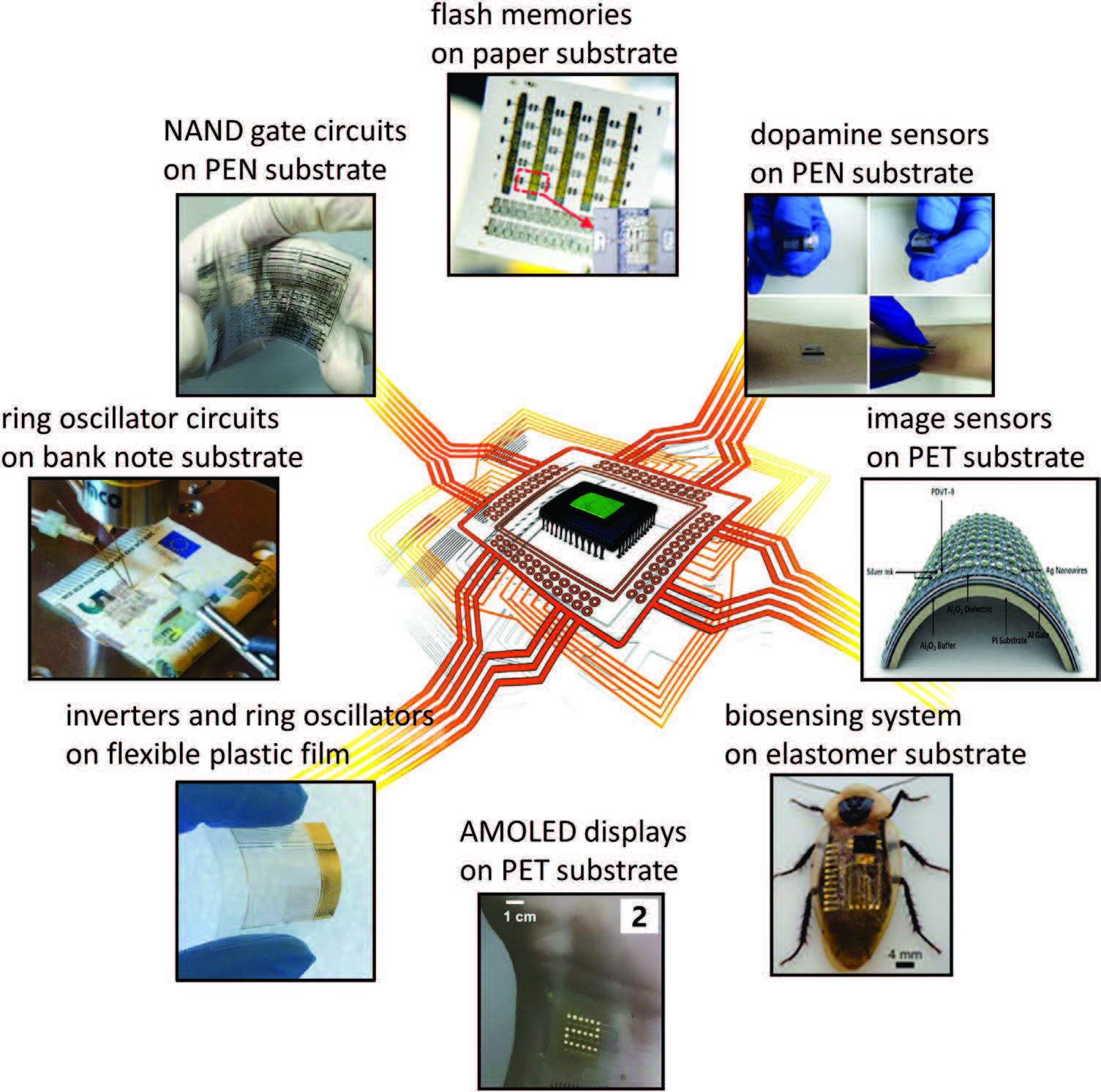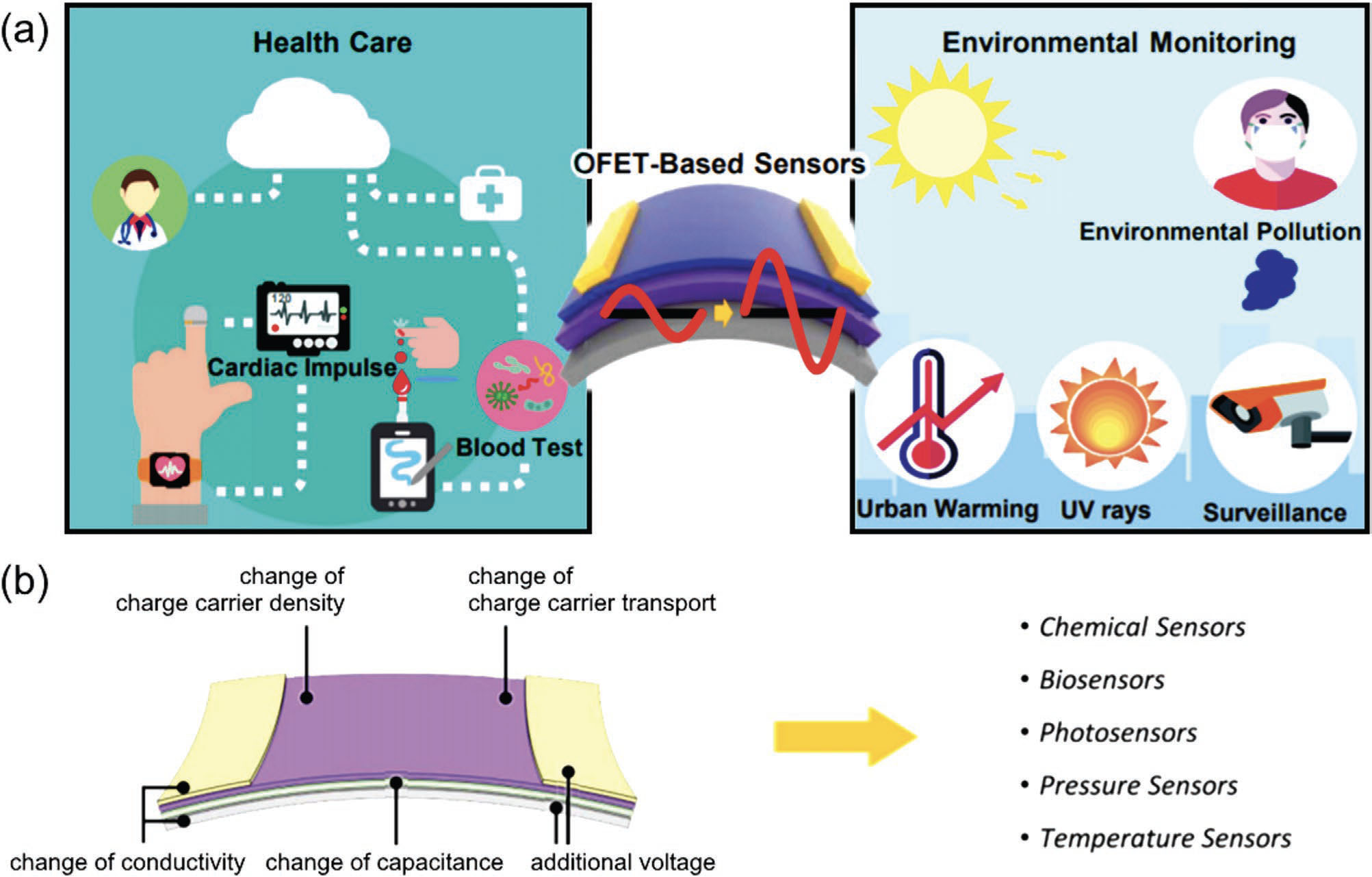| Mar 28, 2023 | |
Recent progress of OFET technology |
|
| (Nanowerk Spotlight) Flexible electronics, an area of significant attention in academia and industry, is poised to revolutionize various sectors, such as lighting technology, power integration displays, and health monitoring systems. Flexible electronics offer unique benefits, including cost-effectiveness, low-temperature processability, mechanical softness, and shape adaptability. | |
| A recent review takes a look at the progress of organic field-effect transistors (OFETs) and their potential applications in flexible electronics. The authors explore the recent progress of OFET technology and some of the exciting, flexible electronic applications addressed by it (Advanced Materials, "Impact of Planar and Vertical Organic Field-Effect Transistors on Flexible Electronics"). | |
 |
|
| Some important electronic applications enabled by the flexible OFET technology. (Reprinted with permission by Wiley-VCH Verlag) | |
The Rise of Organic Field-Effect Transistors (OFETs) |
|
| Traditional inorganic MOSFETs and hydrogenated-amorphous-silicon (a-Si:H) TFTs are mechanically rigid and require high processing temperatures, limiting their use in flexible electronics. Organic FETs (OFETs), however, present a viable alternative. They are mechanically flexible, can be deposited at low temperatures, and are made using low-cost solution-processable methods. | |
| Since the initial reports on OFETs in the 1980s, there have been continuous improvements in device performance and reliability, leading to increased charge carrier mobility. Today, OFETs can address next-generation applications, such as flexible active-matrix organic light-emitting diode (AMOLED) displays and flexible electronic papers. | |
Flexible OFET Applications |
|
| As flexibility becomes essential for next-generation electronics, integrating devices into biological systems and Internet-of-Things IoT technologies is crucial. The demand for flexibility has spurred advances in OFET-based applications, including logic circuits, light-emitting devices, flash memories, and chemical, physical, and biosensing systems. | |
| Organic Circuits | |
| OFETs have paved the way for flexible organic circuits, including logic gates, oscillators, and amplifiers, which are essential building blocks for applications such as OLED displays, RFID tags, and sensory systems. | |
Light-Emitting Displays |
|
| OFET technology is ideal for backplanes in AMOLED applications due to the excellent mechanical properties of organic semiconductor materials, fast response time, and slim profile. Continuous research in this area has led to the development of innovative display systems like rollable OLEDs, multiphoton emission OLED structures, and quantum dot light-emitting systems. | |
| Flexible Memory | |
| OFET technology enables flexible memory solutions with low cost, low-temperature processability, mechanical flexibility, and large-area processing. OFET memories can perform multi-bit storage, charge modulation, and non-destructive readout without additional circuit components. | |
| Sensors | |
| OFETs have been applied as flexible chemical, physical, and biosensors, displaying promising performance due to their sensitivity to physical stimuli and chemical environments. Molecular engineering approaches allow precise adjustments of sensitivity and selectivity in these materials. | |
 |
|
| a) OFET-based sensors bring great promise in addressing and advancing next-generation systems, such as those related to health care and environmental monitoring. b) Factors that modify the output current of OFET-based sensors.(Reprinted with permission by Wiley-VCH Verlag) | |
Planar vs. Vertical OFET Technologies |
|
| Planar OFET (POFET) technology has played a significant role in testing the compatibility of novel organic semiconductor materials and developing cutting-edge fabrication techniques for flexible and conformal devices. In contrast, vertical OFET (VOFET) technology is relatively new, with the first reports emerging in 2004. | |
| VOFETs offer certain advantages over POFETs due to their thin geometry and unique charge transport direction. The channel length in VOFETs can be easily downscaled to nanometer or even monolayer scale without the need for high-cost fabrication techniques. This helps achieve higher current densities and working frequencies at lower operating voltages, ensuring applications in critical areas of organic electronics. Moreover, VOFETs are more suitable for flexible applications, as minor dislocations or cracks in the channel layer have minimal effect on the charge transport process under repeated bending cycles. | |
Conclusion and outlook |
|
| In conclusion, the mechanical flexibility of OFET devices is crucial for developing next-generation conformable electronics. Innovative fabrication techniques and device architectures, such as VOFETs, are being explored to improve current drive capabilities and switching speeds. VOFETs offer the advantage of easy downscaling and lower operating voltages compared to conventional POFETs. However, more research is needed to determine the compatibility of organic semiconductor materials with these advanced architectures. | |
| VOFET technology has shown limited research in flexible electronic applications, with more investigation needed to understand how mechanical flexibility affects electrical properties. Developing thinner, more compact OFET devices is essential for rollable displays, and VOFETs provide a feasible solution due to their nanoscale channel lengths. | |
| There is a need to balance the electrical performance and mechanical compliance of organic semiconductor materials. Researchers are exploring strategies such as blending OSCs with elastomers and employing strain-engineered nanomembranes. Additionally, more research is required to develop multifunctional materials that possess favorable electrical and physical characteristics alongside high flexibility and stretchability. | |
| Finally, researchers should focus on applying OFET devices in complex integrated systems and practically applicable e-skins by combining existing methods with large-area techniques, such as roll-to-roll manufacturing. Addressing these challenges will pave the way for more innovative, flexible applications based on organic transistor devices. | |
 By
Michael
Berger
– Michael is author of three books by the Royal Society of Chemistry:
Nano-Society: Pushing the Boundaries of Technology,
Nanotechnology: The Future is Tiny, and
Nanoengineering: The Skills and Tools Making Technology Invisible
Copyright ©
Nanowerk LLC
By
Michael
Berger
– Michael is author of three books by the Royal Society of Chemistry:
Nano-Society: Pushing the Boundaries of Technology,
Nanotechnology: The Future is Tiny, and
Nanoengineering: The Skills and Tools Making Technology Invisible
Copyright ©
Nanowerk LLC
|
|
|
Become a Spotlight guest author! Join our large and growing group of guest contributors. Have you just published a scientific paper or have other exciting developments to share with the nanotechnology community? Here is how to publish on nanowerk.com. |
|
